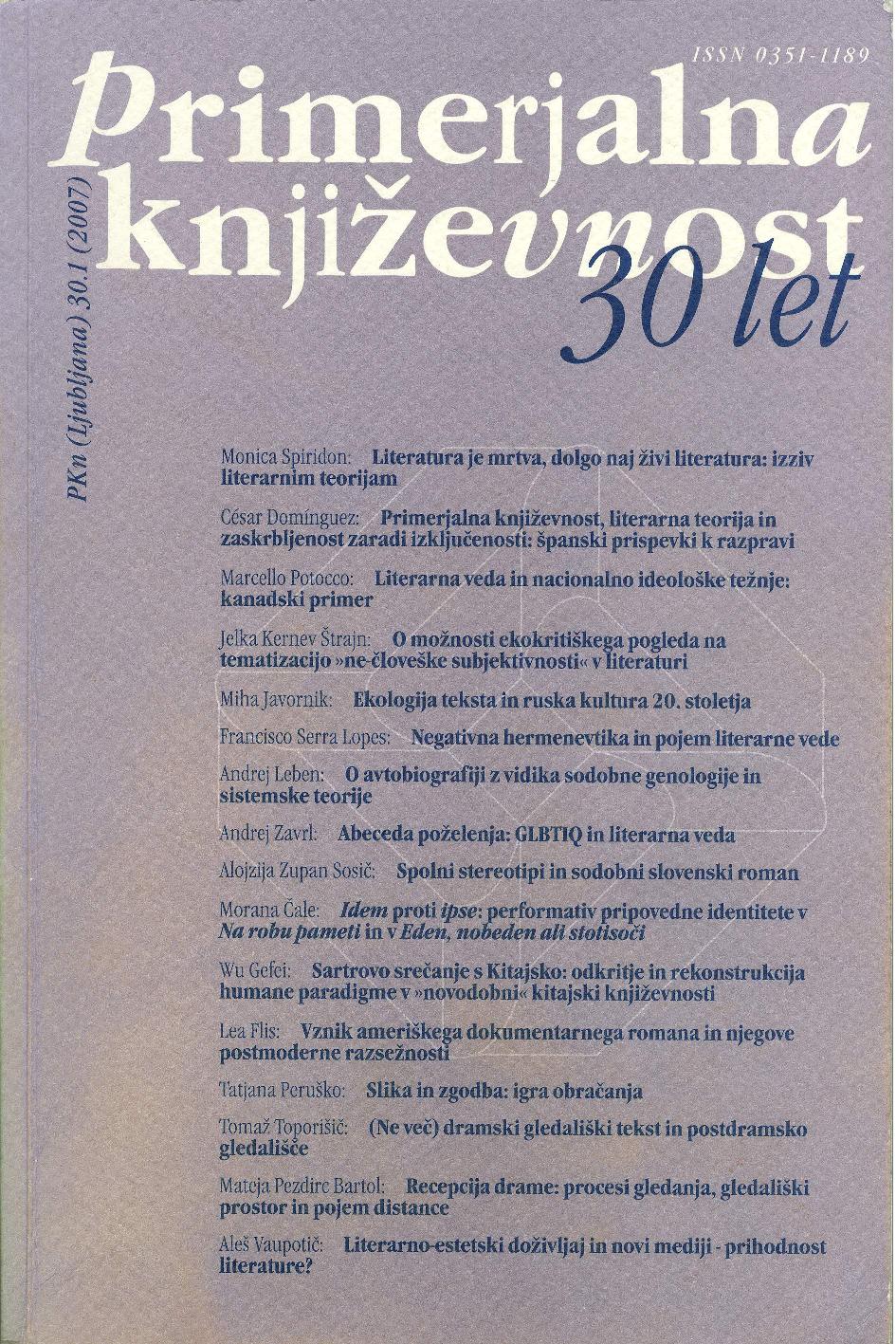Sexual Stereotypes and the Modern Slovenian Novel
Keywords:
Slovene literature, Slovene novel, sexual roles, sexual stereotypesAbstract
In the modern Slovenian novel (1990–2007), the creative and functional dynamics of sexual stereotypes are characterized by a new emotionality and a feeling for shifts in sexual identity. In the new emotionality, links to traditional literature are present in the form of disassembling, rearrangement, and re-evaluation of literary schematisms and automatisms, among which sexual stereotypes predominate. In the modern Slovene novel (Filio ni doma [Filio Is Not Home], Muriša, Camera obscura, Nespečnost [Insomnia], Angeli in volkovi [Angels and Wolves], and Ime tvoje zvezde je Bilhadi [The Name of Your Star Is Bilhadi]), these stereotypes were decisively influenced by the global sexual stereotype of “the man is the head, and the woman is the heart” with its forced discriminating binariness, which is broken down into the following sexual stereotypes: the woman as dark continent, the woman as house angel, femme fatale, femme fragile, Don Juan, and the man as family protector. Among these, the dark continent has the broadest semantic field, which introduces the issues of understanding femininity, but at the same time, and in combination with the house angel and femme fatale, this stereotype is the most frequent in the modern Slovene novel. In the modern Slovenian novel, sexual stereotyping, the process of generalizing genders or gender roles establishes itself at various levels, most frequently at the level of characterization. The most traditional stereotype image of the male and female genders among the novels selected has been outlined in the novels Muriša by Feri Lainšček and Camera obscura by Nejc Gazvoda. When both writers failed to establish a narrative distance to sexual stereotypes, stereotyping at the level of characterization was also transferred to other narrative levels – that is, it weakened the sequence of events, the plot structure, and the narrative perspective. Sexual stereotypes were more successfully broken by the authors in the novels Filio ni doma and Nespečnost because they reshaped them with humor, irony, and the grotesque in the sense of post-postmodernist aesthetics. A special alienation of sexual stereotypes in the novels Angeli in volkovi and Ime tvoje zvezde je Bilhadi was enabled by the chronotopic shift and the children’s perspective, which retained partial stereotyping at the level of characterization known for its non-sexism and reaching beyond the traditional mental horizon.References
Bautista Valejo, José M. in Tatjana Bijol. Seksistični stereotipi v vzgoji. Sevilla: Libros Editores, 2001.
Blagojević, Marina. »Mizoginija: kontekstualna i/ili univerzalna?« Polni stereotipi. Nova srpska politička misao (posebno izdanje). Beograd: Časopis za političku teoriju i društvena iztraživanja, 2002. 21–39.
Blažič, Jasna. Angeli in volkovi (Metamorfoze neke ulice v devetih slikah iz otroštva). Ljubljana: CZ, 2004.
Bojetu, Berta. Filio ni doma. Celovec–Salzburg: Založba Wieser, 1990.
Cankar, Franc, Branko Slivar in Vlado Milekšič. »Vloga in pomen spolnih stereotipov v samopodobi učencev in učenk.« Anthropos 35.1/4 (2004): 315–326.
Castillo, Durante, Daniel. Du stéréotype à la litterature. Quebec: XYZ éditeur, 1994.
Gazvoda, Nejc. Camera obscura. Novo mesto: Založba Goga, 2006.
Gilmore D., David. Manhood in the Making. Cultural Concepts of Masculinity. London: Yale University Press, 1990.
Hark, Helmut. Leksikon osnovnih jungovskih pojmova. Beograd: Dereta, 1998. (Biblioteka Savremena psihologija).
Irigary, Luce. Jaz, ti, me, mi. Za kulturo različnosti. Ljubljana: Znanstveno in publicistično središče, 1995. (Mala edicija ZPS, 9).
Jarić, Isidora. »Rodni stereotipi.« Polni stereotipi. Nova srpska politička misao (posebno izdanje). Beograd: Časopis za političku teoriju i društvena iztraživanja, 2002. 5–21.
Jogan, Maca. Družbena konstrukcija hierarhije med spoloma. Ljubljana: FSPN, 1990.
Kandido Jakšić, Maja. »Polni stereotipi i homoseksualnost.« Polni stereotipi. Nova srpska politička misao (posebno izdanje). Beograd: Časopis za političku teoriju i društvena iztraživanja, 2002. 63–90.
– – –. »Socialno-psihološki i politički kontekst polnih stereotipa.« Polni stereotipi. Nova srpska politička misao (posebno izdanje). Beograd: Časopis za političku teoriju i društvena iztraživanja, 2002. 39–63.
Kobal, Darja. Temeljni vidiki samopodobe. Ljubljana: Pedagoški inštitut, 2000.
Koren Valenčič, Katja. Stereotipi in seksizem v izvirni slovenski slikanici (in ilustraciji) (1990–1997). Diplomska naloga (mentor I. Saksida). Ljubljana: Oddelek za slovanske jezike in književnosti na Filozofski fakulteti, 1999.
Lainšček, Feri. Muriša. Ljubljana: Študentska založba, 2006. (Knjižna zbirka Beletrina).
Mihurko Poniž, Katja. Drzno drugačna: Zofka Kveder in podobe ženskosti. Ljubljana: Delta, 2003.
Moi, Toril. Politika spola/teksta: feministična literarna teorija. Ljubljana: Literarno-umetniško društvo Literatura, 1999. (Zbirka Labirinti).
Mosse L., George. The Image of Man. The Creation of Modern Masculinity. Oxford: Oxford University Press, 19982.
Möderndorfer, Vinko. Nespečnost. Pripovedovanje v 31 spominjanjih. Ljubljana: CZ, 2006.
Musek, Janek. Psihološki portret Slovencev. Ljubljana: Znanstveno in publicistično središče, 1994.
Novak A., Boris. »Senca preteklosti (o romanu Vinka Möderndorferja Nespečnost).« Nespečnost. Pripovedovanje v 31 spominjanjih. Vinko Möderndorfer. Ljubljana: CZ, 2006.
Plesničar, Andreja. »Ženske in ’ženski’ romani.« Knjižnica 4 (1995): 85–113.
Reja, Magda. Ime tvoje zvezde je Bilhadi. Ljubljana: Založba Sanje, 2006.
Schneider J., David. The Psychology of Stereotyping. New York: The Guilford Press, 2004.
Szajbély, Mihály. »Stereotipi kao strukturni elementi u riječkome romanu Igrač koji dobiva (1882) Maurusa Jókaija.« Kulturni stereotipi. Koncepti identiteta u srednjoevropskim književnostima. Ur. Dubravka Oraić Tolić in Erni Kulcsar Szabó. Zagreb: FF press, 2006.
Šlibar, Neva. »Zakaj in kako preko književnosti vzgajati za strpnost, sprejemanje drugačnosti in tujosti?« Barve strpnosti, besede drugačnosti, podobe tujosti: vzgoja za strpnost in sprejemanje drugačnosti preko mladinske književnosti. Ur. Neva Šlibar. Ljubljana: FF, 2006. 13–47.
Zupan Sosič, Alojzija. »Gender Identities in the Contemporary Slovene Novel.« http://clcwebjournal.lib.purdue.edu/clcweb06-3/contents06-3..html.
– – –. Robovi mreže, robovi jaza: sodobni slovenski roman. Maribor: Litera, 2006.
– – –. »Sodobna slovenska proza.« Svetovni dnevi slovenske literature. Ur. Alojzija Zupan Sosič in Mojca Nidorfer Šiškovič. Ljubljana: Center za slovenščino kot drugi/tuji jezik pri Oddelku za slovenistiko Filozofske fakultete, 2006. 13–17.


